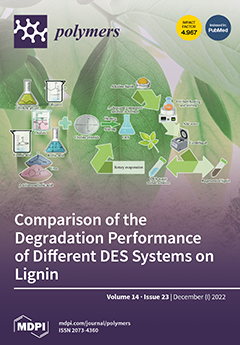The hydrophilicity and inherent flammability of cotton textiles severely limit their usage. To solve these drawbacks, a superhydrophobic and flame-retardant (SFR) coating made of chitosan (CH), ammonium polyphosphate (APP), and TiO
2-SiO
2-HMDS composite was applied to cotton fabric using simple
[...] Read more.
The hydrophilicity and inherent flammability of cotton textiles severely limit their usage. To solve these drawbacks, a superhydrophobic and flame-retardant (SFR) coating made of chitosan (CH), ammonium polyphosphate (APP), and TiO
2-SiO
2-HMDS composite was applied to cotton fabric using simple layer-by-layer assembly and dip-coating procedures. First, the fabric was alternately immersed in CH and APP water dispersions, and then immersed in TiO
2-SiO
2-HMDS composite to form a CH/APP@TiO
2-SiO
2-HMDS coating on the cotton fabric surface. SEM, EDS, and FTIR were used to analyze the surface morphology, element composition, and functional groups of the cotton fabric, respectively. Vertical burning tests, microscale combustion calorimeter tests, and thermogravimetric analyses were used to evaluate the flammability, combustion behavior, thermal degradation characteristics, and flame-retardant mechanism of this system. When compared to the pristine cotton sample, the deposition of CH and APP enhanced the flame retardancy, residual char, heat release rate, and total heat release of the cotton textiles. The superhydrophobic test results showed that the maximal contact angle of SFR cotton fabric was 153.7°, and possessed excellent superhydrophobicity. Meanwhile, the superhydrophobicity is not lost after 10 laundering cycles or 50 friction cycles. In addition, the UPF value of CH/APP@TiO
2-SiO
2-HMDS cotton was 825.81, demonstrating excellent UV-shielding properties. Such a durable SFR fabric with a facile fabrication process exhibits potential applications for both oil/water separation and flame retardancy.
Full article






